

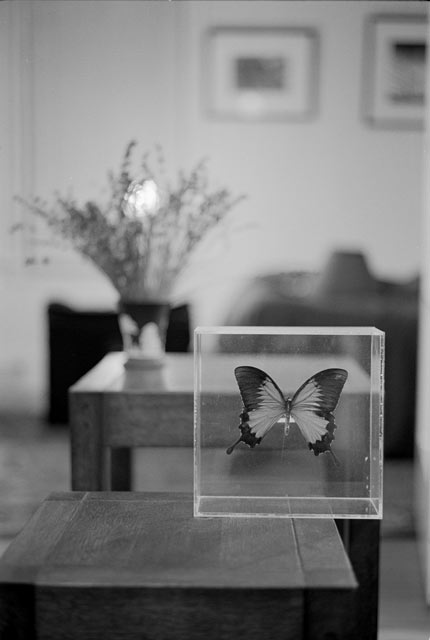
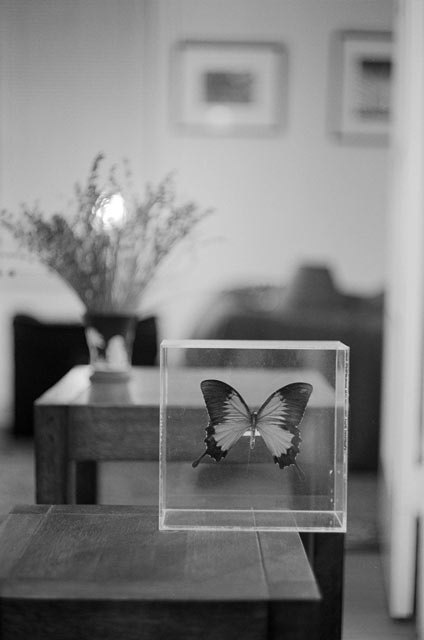
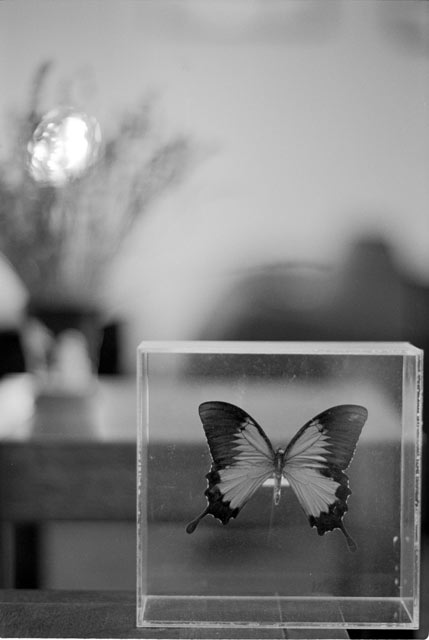
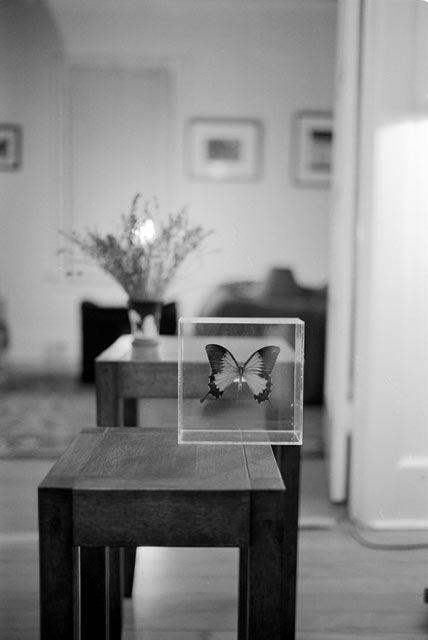
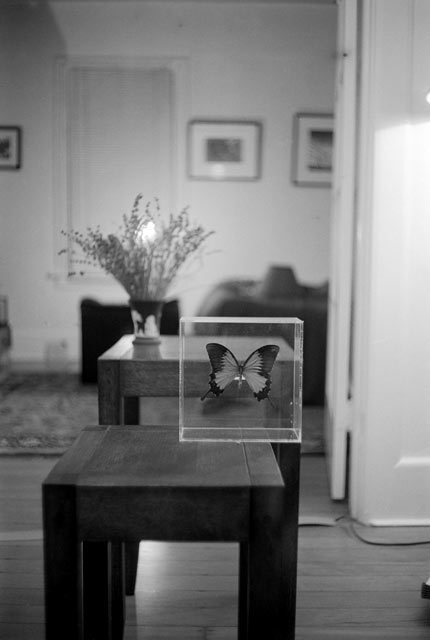
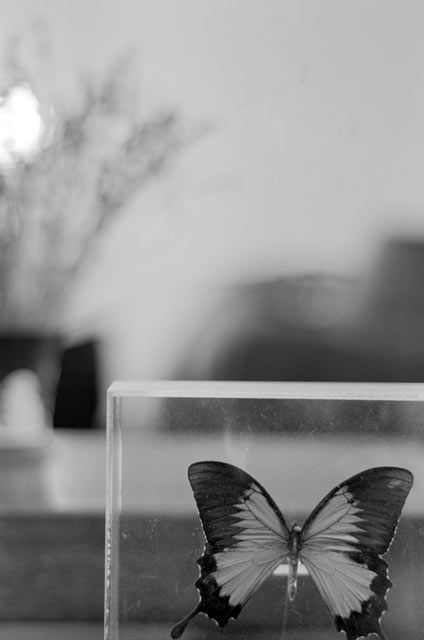
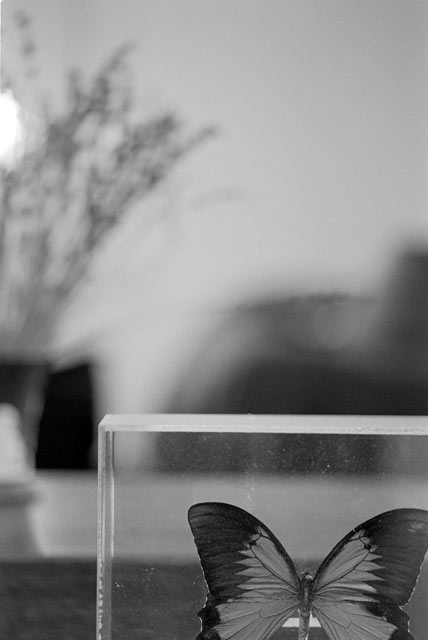
Wide Open and Close Up: Nine Lenses for Leica M
As I like shooting my lenses close up and wide open, I decided I would finish a roll by taking one picture each of the same scene with each of my M lenses (excluding super-wides). I took two tables and put a mounted butterfly on the front one, and a vase with cut lavender in the second. Directly behind the lavender, I put a bare bulb. My intention was to simulate the effect that one gets when having an out of focus tree with the sun behind in...it can lead to good, or really distracting bokeh. In this case, I think all handled it well, but it was probably too direct of a light source. The following pictures were all taken at 1m using the widest aperture of the lens (except for the Canon 35mm f/1.8...I shot that at f/2 for a better exposure). They were taken on my MP using the focusing magnifier and Delta 100 developed in D76 1:1. My point of focus was the upper left tip of the wing on the butterfly. I used a cable release and a tripod for each exposure. The first thing that you will probably notice is how the lenses are almost indistinguishable in terms of quality. All of the lenses tested were very good, but they do vary more than is indicated in this comparison. This is largely because I adjusted all the images so that their brightness, contrast and tonal range was similar. If this test was done on slide film, there would be a greater difference in terms of contrast and the rendition of colors. The older lenses have lower contrast, and their colors are less saturated. The oldest of the bunch -- the summicron collapsible and the Canon 35mm lens would have a pastel-like rendering, compared to the latest ASPH lenses vibrant colors. In terms of resolution, they are all very good, but the differences show up more readily on viewing the images at 100%, or by making large prints. Examining the scans, it appears that of the 50mm lenses, the modern 50mm summicron has the greatest flat field resolution, but the Summilux ASPH seems to resolve three-dimensional images better. The area I notice this was in the butterfly's head and wings. The summicron did better with the wings, but the summilux did better with the head. It is important to remember that the Summilux is going toe to toe with the Summicron, and yet it is a stop faster. Something else I found from the test was that the 35mm f/1.4 ASPH seems to be slightly off in terms of focus. Either that, or I misfocused. It's sharpest point seems to be in the wood grain on the table immediately in front of the butterfly. Comparing the butterfly, the Canon is certainly sharper. Though I don't doubt the Canon is a sharp lens, I think this one bears retesting. Another interesting feature was the bit of "glow" in the 50mm f/1.2 Hexanon and the 75mm f/1.4 summilux. Both lenses seemed to exhibit a slight fuzzy-ness in the edges of the butterfly's wings. This was not the same as blurriness or misfocus -- it appears to be a slight lightening and softening of fine detail. The detail is still there, but it is very slightly tempered. I assume that this comes from some a small amount of uncorrected spherical aberration or coma present at these high speeds. I think this may account for the very pleasant character of these lenses. The 75mm in particular is ideal for portraits, and this may be part of the reason why. Of course, stopping these lenses down 1 or 2 stops removes the traces of these "errors". The final surprise was the comparison between the 90mm tele-elmarit and the Canon RF 100mm f/3.5. Unfortunately, since I don't have an external viewfinder it is difficult to accurately frame the 100mm lens. What was interesting however, was that the 100mm Canon clearly revealed much more detail and was far sharper than the 90mm Tele-Elmarit M. Since the 90mm has been one of my sharpest lenses in actually use, I must conclude that it either loses a good deal of performance wide open and close up, or it is not focusing correctly. The Canon may indeed be sharper (all else being equal, usually slower lenses are sharper), but I don't suspect it would be as superior as it was in the test. All in all the experiment was interesting and offered some surprises. Of all the lenses, I would say the best combination of speed and sharpness is the 50mm f/1.4 summilux ASPH, the smoothest 50mm is the Hexanon, and the 75mm would be my overall pick for the nicest image character. I am withholding judgement on the 35mm and 90/100mm tests because of the focus issues. |
 |
 |
50mm f/1.2 M-Hexanon Limited @f/1.2 |
50mm f/1.4 Summilux ASPH @f/1.4 |
 |
 |
50mm f/2 Summicron (latest) @f/2 |
50mm f/2 Summicron Collapsible (1956) @f/2 |
 |
|
75mm f/1.4 Summilux @f/1.4 |
|
 |
 |
35mm f/1.4 Summilux ASPH @f/1.4 |
35mm f/1.8 Canon RF @f/2 |
 |
 |
90mm f/2.8 Tele-Elmarit M @f/2.8 |
100mm f/3.5 Canon RF @f/3.5 |